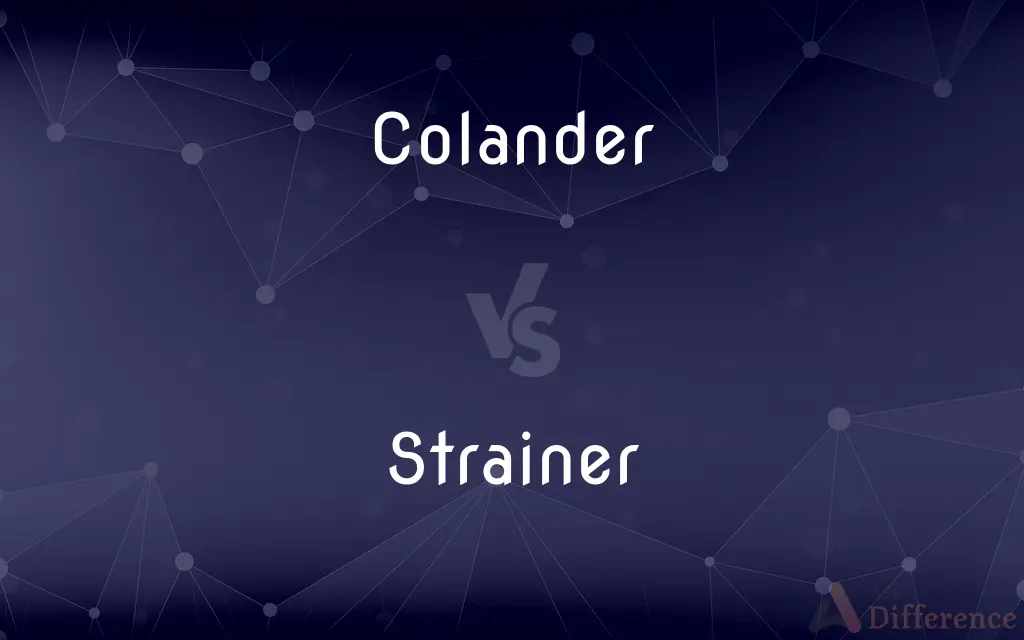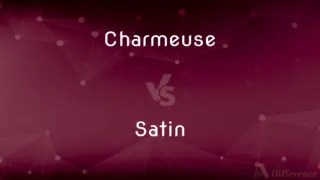Colander vs. Strainer — What's the Difference?
Edited by Tayyaba Rehman — By Fiza Rafique — Updated on September 22, 2023
A "Colander" is a perforated bowl used for draining off liquid from food, commonly pasta or washed fruits. A "Strainer," while also used for separating liquids from solids, usually has a finer mesh and may come with a handle or supports.

Difference Between Colander and Strainer
Table of Contents
ADVERTISEMENT
Key Differences
"Colander" and "Strainer" are both kitchen utensils primarily used to separate liquids from solids, but they differ in design and usage. A colander is typically a bowl-shaped utensil with holes in it, used for draining larger food items like pasta, vegetables, or fruits. A strainer usually has a finer mesh or perforations and is often used for more delicate tasks, such as sifting flour or separating tea leaves from brewed tea.
A colander usually stands alone with a flat base and might not have a handle. It's designed for draining large quantities of food and can often be set inside a sink to allow for hands-free draining. On the other hand, a strainer usually comes with a handle and is held or placed over a bowl or pot to catch finer particles, making it more versatile for different cooking tasks.
The holes in a colander are generally larger and are designed to drain water quickly. This makes colanders less suitable for straining fine particles. Strainers, in contrast, have smaller perforations or a fine mesh that allows them to separate even small bits from a liquid, making them ideal for jobs that require finer separation.
Colanders are often made from plastic or metal and may even have extendable "arms" to fit securely over a sink. Strainers are generally made from metal, cloth, or fine mesh and may come in various shapes and sizes, including flat, conical, or cup-shaped forms.
Comparison Chart
Design
Bowl-shaped with holes
Finer mesh, may have handle
ADVERTISEMENT
Hole Size
Larger
Smaller
Usage
Draining large food items
Straining fine particles
Material
Plastic or metal
Metal, cloth, or fine mesh
Handle
May not have a handle
Usually has a handle
Compare with Definitions
Colander
A drainer for rinsing fruits and vegetables.
I always use a colander to rinse my fruits before eating them.
Strainer
A device for separating liquids from solids, typically having a fine mesh or perforations.
Use a strainer to remove the lemon seeds from the juice.
Colander
A kitchen tool used for straining and draining.
She placed the colander in the sink to drain the cooked rice.
Strainer
A kitchen tool with a mesh, used for filtering substances.
Pour the tea through a strainer to remove the leaves.
Colander
A kitchen utensil with holes, used for separating solids from liquids.
Place the washed grapes in a colander to let the water drain off.
Strainer
A sieve-like utensil used in cooking or food preparation.
He used a strainer to sift the flour for the cake recipe.
Colander
A perforated bowl for draining liquids from food.
I used the colander to drain the pasta.
Strainer
A sieve used for various tasks in the kitchen, including sifting and straining.
She held the strainer over the bowl to catch any lumps in the batter.
Colander
A bowl-shaped sieve used in cooking.
Put the boiled vegetables in a colander to remove excess water.
Strainer
A device having holes punched in it or made of crossed wires for separating solid matter from a liquid
A tea strainer
Colander
A colander (or cullender) is a kitchen utensil used to strain foods such as pasta or to rinse vegetables. The perforated nature of the colander allows liquid to drain through while retaining the solids inside.
Strainer
One that strains, as a device used to separate liquids from solids.
Colander
A perforated bowl used to strain off liquid from food after washing or cooking.
Strainer
A standing or fallen tree whose branches are partly submerged in a fast-flowing river, presenting a hazard to navigation or to swimmers.
Colander
A bowl-shaped kitchen utensil with perforations for draining off liquids and rinsing food.
Strainer
An apparatus for tightening, stretching, or strengthening.
Colander
A bowl-shaped kitchen utensil with holes in it used for draining food that has been cooking in water, such as pasta.
Strainer
A device through which a liquid is passed for purification, filtering or separation from solid matter; anything (including a screen or a cloth) used to strain a liquid.
Colander
A utensil with a bottom perforated with little holes for straining liquids, mashed vegetable pulp, etc.; a strainer of wickerwork, perforated metal, or the like.
Strainer
A perforated screen or openwork (usually at the end of a suction pipe of a pump), used to prevent solid bodies from mixing in a liquid stream or flowline.
Colander
Bowl-shaped strainer; used to wash or drain foods
Strainer
One who strains.
Strainer
One who strains.
Strainer
That through which any liquid is passed for purification or to separate it from solid matter; anything, as a screen or a cloth, used to strain a liquid; a device of the character of a sieve or of a filter; specifically, an openwork or perforated screen, as for the end of the suction pipe of a pump, to prevent large solid bodies from entering with a liquid.
Strainer
A filter to retain larger pieces while smaller pieces and liquids pass through
Strainer
A utensil used to strain out fine particles from liquids.
Use a strainer to make sure no pulp gets into your orange juice.
Common Curiosities
Can I use a Strainer for draining pasta?
Yes, but it may not be as efficient as using a colander due to the finer mesh.
What is a Colander?
A colander is a bowl-shaped kitchen utensil with holes, used mainly for draining liquids from food.
What is a Strainer?
A strainer is a utensil with a fine mesh or perforations, used for separating liquids from solids.
What materials are Colanders usually made of?
Colanders are often made of plastic or metal.
What are Strainers usually made of?
Strainers are generally made from metal, cloth, or fine mesh.
Is a Strainer the same as a sieve?
A strainer is similar to a sieve but may have a handle and various shapes.
How do I clean a Colander?
Colanders can be cleaned with soap and water, and many are dishwasher-safe.
Can I use a Colander for sifting flour?
No, a colander's holes are generally too large for sifting flour. A strainer would be better suited.
Which one is better for washing fruits?
A colander is generally better for washing fruits because of its larger holes.
Can a Strainer be used for tea?
Yes, a strainer is often used to separate tea leaves from brewed tea.
How do I clean a Strainer?
Strainers should be rinsed immediately after use and can be cleaned with a brush.
Do Colanders have handles?
Some do, but many are designed to stand alone without handles.
Do Strainers have handles?
Most strainers come with a handle for easy use.
Are there different sizes of Colanders and Strainers?
Yes, both come in various sizes depending on your needs.
Is a Colander the same as a Strainer?
No, a colander is generally bowl-shaped with larger holes, while a strainer has a finer mesh.
Share Your Discovery

Previous Comparison
Bookstaff vs. Letter
Next Comparison
Charmeuse vs. SatinAuthor Spotlight
Written by
Fiza RafiqueFiza Rafique is a skilled content writer at AskDifference.com, where she meticulously refines and enhances written pieces. Drawing from her vast editorial expertise, Fiza ensures clarity, accuracy, and precision in every article. Passionate about language, she continually seeks to elevate the quality of content for readers worldwide.
Edited by
Tayyaba RehmanTayyaba Rehman is a distinguished writer, currently serving as a primary contributor to askdifference.com. As a researcher in semantics and etymology, Tayyaba's passion for the complexity of languages and their distinctions has found a perfect home on the platform. Tayyaba delves into the intricacies of language, distinguishing between commonly confused words and phrases, thereby providing clarity for readers worldwide.














































